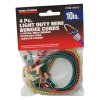Finally got around to building the bucket version for my 50 breeder zoanthid tank that is overrun with hair algae.
A couple discoveries while constructing that people may or may not have thought of:
1) I didn't have time to get a bulkhead fitting, so in my craftiness I thought I'd improvise some parts from my local Lowe's plumbing department.
1 - 1" to 1.25" adapter male thread 1" slip 1.25"
1 - 1" threaded pipe adapter female threaded and slip
2 - 1.5" rubber washer
less than $3
2) has anyone used thick rubberbands and 2 paperclips to secure the top pipe to the bucket?
take a thick rubberband
lay it across the pipe
thread a paper clip on each side through the loop
bend the pointy end out a tiny bit to form a hook
hook one side under the lip of the bucket where the handle connects
hook the other side
repeat for the opposite side of the pipe
basically you've made a mini bungee with a thick rubber band and 2 paper clips
I'm sure there's mini bungees out there somewhere that you could just buy. I haven't looked though.
There's my 2 tips.
I have to switch over my sump from the 40 long to the 10 gallon, build a shelf for my bucket, leak test all my connections, and get my lights set up then I'll take pictures.
Is a fan necessary if the bucket isn't under the aquarium in the stand?
The first adapter goes inside the bucket, the second outside, a rubber washer on both sides of the bucket wall.



A couple discoveries while constructing that people may or may not have thought of:
1) I didn't have time to get a bulkhead fitting, so in my craftiness I thought I'd improvise some parts from my local Lowe's plumbing department.
1 - 1" to 1.25" adapter male thread 1" slip 1.25"
1 - 1" threaded pipe adapter female threaded and slip
2 - 1.5" rubber washer
less than $3
2) has anyone used thick rubberbands and 2 paperclips to secure the top pipe to the bucket?
take a thick rubberband
lay it across the pipe
thread a paper clip on each side through the loop
bend the pointy end out a tiny bit to form a hook
hook one side under the lip of the bucket where the handle connects
hook the other side
repeat for the opposite side of the pipe
basically you've made a mini bungee with a thick rubber band and 2 paper clips
I'm sure there's mini bungees out there somewhere that you could just buy. I haven't looked though.
There's my 2 tips.
I have to switch over my sump from the 40 long to the 10 gallon, build a shelf for my bucket, leak test all my connections, and get my lights set up then I'll take pictures.
Is a fan necessary if the bucket isn't under the aquarium in the stand?
The first adapter goes inside the bucket, the second outside, a rubber washer on both sides of the bucket wall.





